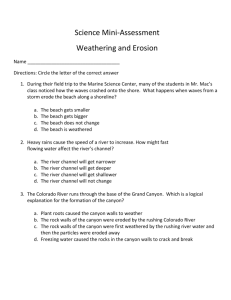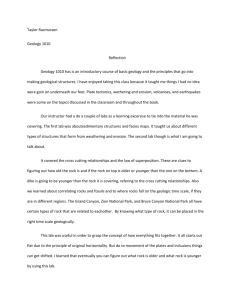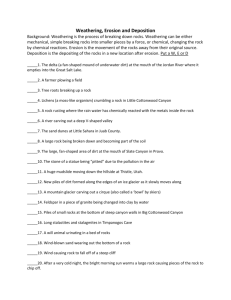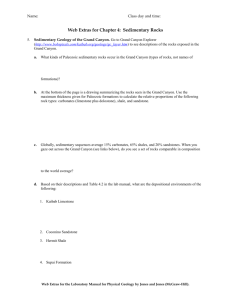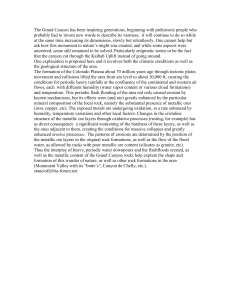lesson27
advertisement
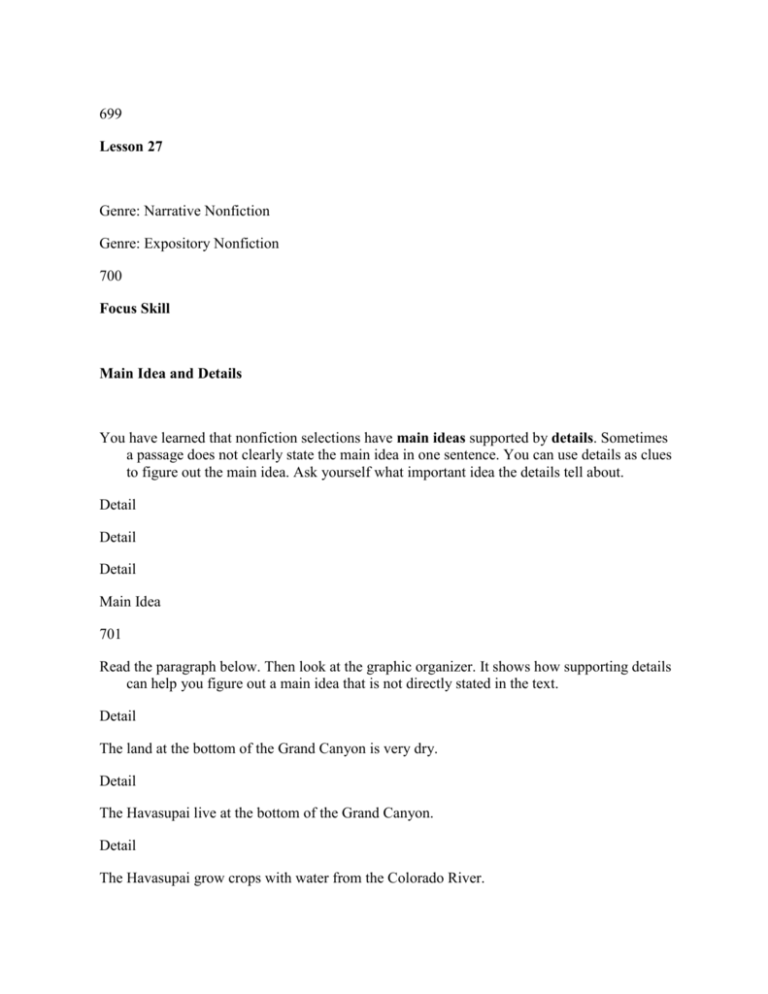
699 Lesson 27 Genre: Narrative Nonfiction Genre: Expository Nonfiction 700 Focus Skill Main Idea and Details You have learned that nonfiction selections have main ideas supported by details. Sometimes a passage does not clearly state the main idea in one sentence. You can use details as clues to figure out the main idea. Ask yourself what important idea the details tell about. Detail Detail Detail Main Idea 701 Read the paragraph below. Then look at the graphic organizer. It shows how supporting details can help you figure out a main idea that is not directly stated in the text. Detail The land at the bottom of the Grand Canyon is very dry. Detail The Havasupai live at the bottom of the Grand Canyon. Detail The Havasupai grow crops with water from the Colorado River. Main Idea The Havasupai have developed a way of life that allows them to live in a very dry place. www.harcourtschool.com/storytown 702 Vocabulary Build Robust Vocabulary The Amazing Power of Rivers embedded distant cascading ancient eroding glistens sentries weary Throughout the world, rivers have created landforms that amaze travelers. In the American Southwest, the Colorado River has carved the Grand Canyon out of layers of colorful rock. It has exposed rock embedded with fossils. In East Africa, the Zambezi River has created another natural wonder. Visitors to this distant place are rewarded with an amazing sight. The broad, gently flowing Zambezi suddenly pours over cliffs. The cascading waters form Victoria Falls, one of the largest waterfalls in the world. 703 The falling water drops into a deep canyon. It then roars through a narrow gorge. Since ancient times, the river has been eroding the rock there. Sun and mist create rainbows above the gorge. Wet rock glistens where sunshine reaches it. You can see more than rock and water near Victoria Falls. Hippos wallow and antelopes leap. Baboons patrol paths as if they were sentries. Lions prowl nearby. You may be weary after all the hiking you’ll be doing to see it all, but you will always remember the trip! www.harcourtschool.com/storytown 704 Grand Canyon A Trail Throuch Time 705 706 A predawn storm rumbles over Grand Canyon National Park. Cracks of lightning shatter the dark sky, flashing above an enormous plateau of peaks, valleys, and trenches where ancient mountains once stood. The deepest trench is called the Grand Canyon, one of the Seven Natural Wonders of the World. 707 Dawn comes, bringing daylight to spires and buttes standing like sentries on the plateau, worn down by weathering and erosion. Coyotes teach their pups to hunt for food in thick forests along the edges of the Canyon. Thousands of visitors from all over the world have come to view the splendor of the Grand Canyon. In campgrounds and lodges near the north and south rims, they prepare for the day’s activities. 708 The morning sun climbs above distant mountains, revealing cliffs hanging over the Colorado River at the bottom of the Grand Canyon. The river took almost six million years to carve the Canyon, creating a channel about one mile deep and more than 275 miles long. Wind and water wore down its steep sides, widening the chasm between the cliffs. A raven glides across the opening, making lazy circles over the river far below. The sun chases away shadows on the craggy rocks thousands of feet below the rims. Pack mules begin a five-hour trip down to the deepest part of the Canyon. They follow each other along a twisted, ten-mile trail to the riverbed. Clouds of dust follow them as voices from the top fade away. 709 Canyon visitors along the trail peer with curiosity at symbols of people and animals that were painted on a boulder by Havasupai Indians long ago. Havasupai still live in the Canyon today, tending their flocks and farms in the summertime, hunting small game and gathering nuts and berries in the winter months. As the sun moves higher in the sky, smaller side canyons with rocks layered like multicolored ribbons come into view. Bighorn sheep walk easily along the steep walls of the canyons, looking for food in hidden pockets of soil. Wildflowers stand around them in patches of purple and pink. 710 The mules continue down the trail to the inner gorge. They carry their riders past layers of rock that display millions of years of the Earth’s geologic history. A canyon wren looks for bits of brush to line its nest, hidden in a rocky crevice just off the trail. It searches for twigs and grasses up and down the Canyon walls, flying past fossils of fish teeth and seashells. 711 The noonday sun glistens on a hidden creek near a granary built into the Canyon wall by Anasazi Indians almost 1,000 years ago. Squirrels chase through the now-empty granary, where crops and plants had been stored for food and trade. A lizard scurries off the trail. It climbs over fossils of prehistoric trilobites, embedded in layers of shale millions of years ago when the land was covered by a primeval sea. After the mules pass, the lizard creeps out from its hiding place to soak up the warmth of the sun. 712 The afternoon sun hangs low in the sky. A white-breasted nuthatch flies above beavertail cacti along the rocky banks of the Colorado River. Its song drifts over ancient pink, white, and gray rocks at the river’s edge, the roots of the mountains that stood there almost two billion years ago. The water tumbles over cascading rapids, while trout search for quieter streams in which to spawn. A ringtail cat drinks from a slower side stream, watching for predators up and down the red rocks and along the river nearby. Laughter echoes from a bunkhouse, as weary riders and hikers share stories of their descent into the Canyon. 713 The endless cycles of eroding rock and moving water carved the Grand Canyon millions of years ago. Blustering wind and pounding rain continue to widen it, grinding down rocks that used to be mountains and volcanoes. The rushing Colorado River deepens this natural wonder, dragging rocks and mud along its path through ancient plains and lava fl ows. The mules rest for the night in a corral near the river, awaiting tomorrow’s seven-mile trip back up to the top. Weather and erosion make tiny changes every day in the rocky walls along the trail. Millions of years into the future, the same forces of nature will continue to reshape the Grand Canyon, digging even deeper into the history of our planet. 714 Think Critically 1 Reread the first paragraph on page 713. What is the main idea of this paragraph? What details helped you figure out the main idea? main idea and details 2 How do weather and water erode rock? cause and effect 3 Why do you think the author wrote the selection? How do you think she feels about the Grand Canyon? author’s purpose and perspective 4 Think about a visit you have made to a natural area or a park. How do you think the effects of weather may change that area over time? prior knowledge 5 WRITE What can you learn about Earth’s history from the Grand Canyon? Use details and information from the selection to support your answer. short response 715 About the Author Lenda Vieira Linda Vieira says she has been writing her entire life. When she was younger and had a hard time understanding something, she would write it down to make it easier. Later, as an elementary school teacher, she would do the same for her students. Linda Vieira enjoys writing books, such as Grand Canyon, that combine science and history. Grand Canyon is the second book she has worked on with illustrator Christopher Canyon. About the Illustrator Christopher Canyon Award-winning illustrator Christopher Canyon loves to draw, read, and make music. He says creating children’s books is a way to do his favorite things. When not working on a book, he loves playing guitar and singing with his family. He also visits schools and libraries to share his art with others. His advice to young artists is to have fun and celebrate their creativity. He lives in Columbus, Ohio, with his wife, Jeanette, and their cat, Goppy. www.harcourtschool.com/storytown 716 The Rock Cycle Science Expository Nonfiction You might think that rocks never move or change, but did you know that rocks are always changing and moving? Forces of nature, such as heat and erosion, have created mountains, canyons, and volcanoes. If you look closely at the layers that make up the walls of the Grand Canyon, you can see different types of rocks. Read on to learn how nature formed these rocks. Halite is a type of sedimentary rock. It is the natural form of table salt. Sedimentary Rocks Sediment is pieces of rock that have been broken down and moved. Water, wind, and ice break down rock and then carry the sediment. When the wind or water slows down, the sediment falls to the surface. It piles up in layers. The layers get pressed together. Water, carrying minerals, moves through the sediment. Over time, the minerals cause the sediment to stick together. Granite and obsidian are types of igneous rocks. I gneous R ocks Igneous rocks form when melted rock cools and hardens. Deep inside Earth, it is so hot that some rock is liquid, like syrup. This melted rock is called magma. Inside Earth’s crust, magma cools slowly. Volcanic eruptions release magma. When magma reaches Earth’s surface, it is called lava. When the lava cools and hardens, it becomes igneous rock. 717 Magma (molten rock) I gneous (cooled, hardened lava) S ediment (tiny bits of rock) S edimentary (compacted sediment) M etamorphic (changed by heat, pressure) cooling and becoming solid pressure and heat weathering and movement settling and pressing together Marble and slate are metamorphic rocks. M etamorphic R ocks Metamorphic rock is rock that has changed from another type of rock. It can form from any other type of rock, including other metamorphic rock. Heat and pressure form this type of rock. For example, when mountains form, plates that make up Earth’s surface push together. Rock near the surface can get pushed down during this process. Pressure on the rock squeezes it. If the pressure is great enough, minerals in the rock change, forming metamorphic rock. 718 Connections Comparing Texts 1. How would you describe the Grand Canyon to someone who has never seen or read about it? 2. How is “Grand Canyon: A Trail Through Time” similar to and different from “The Rock Cycle”? 3. If you could visit any distant place, where would you go and why? 719
